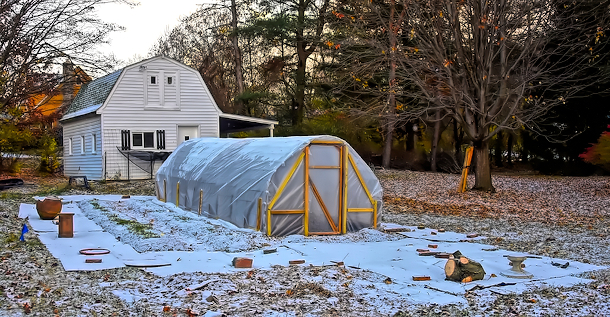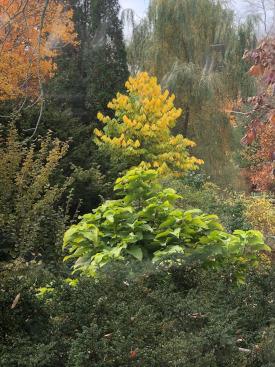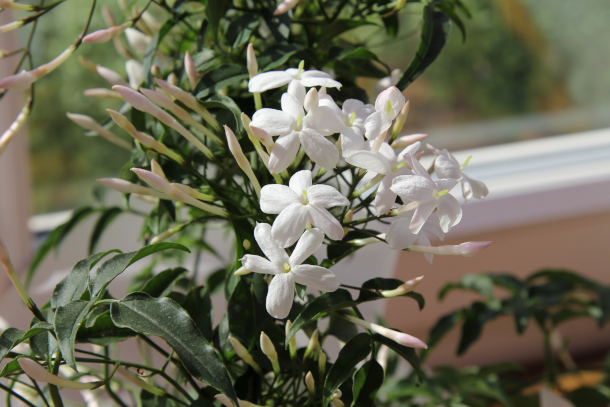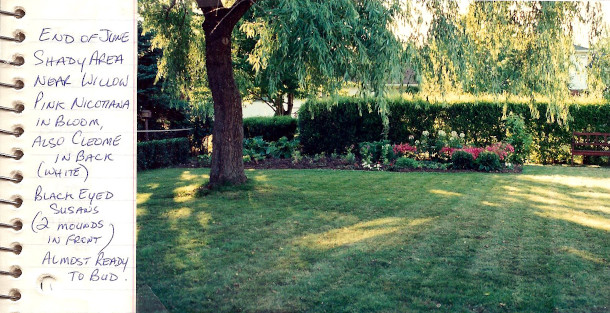Fall Gardening Tips
Air Date: Week of October 30, 2020

One option for gardening during the colder months is building a hoop house, a kind of DIY greenhouse to help extend the growing season. (Photo: Jo Zimny, Flickr, CC BY-ND-ND 2.0)
When the COVID-19 pandemic began, many people found themselves stuck at home, looking for something to do just as spring was getting going. Many turned to gardening as a way to pass the time, and are looking for how to continue this new hobby into the winter. Living on Earth’s Bobby Bascomb chats with landscape designer Michael Weishan, the former host of the PBS series The Victory Garden, about how to keep up with one’s garden and tend to plants inside and out during the colder months of the year.
Transcript
CURWOOD: Now that the chill of fall has settled on many of us, especially in the north, it might seem like gardening season is a distant dream for next year but it doesn’t have to be, according to Michael Weishan. Michael is a landscape designer and former host of the Victory Garden on PBS, and years ago he did a regular gardening segment here on Living on Earth. Living on Earth’s Bobby Bascomb is our resident gardener, and she caught up with Michael for some fall gardening tips.
BASCOMB: So we talked with you, Michael, at the beginning of the pandemic, back in the spring, about taking up gardening as a way to keep busy. And apparently a lot of people did that this summer: garden stores sold out, seeds were hard to come by, did you have that experience as well?
WEISHAN: Absolutely. Thanks to our advocating, of course, people ran out and bought up a ton of stuff. It was crazy. If you went to the nurseries in the springtime, I mean, it was the one thing that people could do. They were mostly open nationwide. And supplies just went immediately. If you were trying to buy seeds in April, it was over and out. And very difficult too, for supplies in general, just things like fertilizer and timber. And if you were gardening this summer, you were you were doing a really heartfelt job because it wasn't the easiest summer to be an avid gardener.
BASCOMB: Well, what advice do you have for someone that maybe decided, okay, I'm going to take up gardening and found it frustrating? Or it didn't work out, you spend all this time and energy and money in many cases, and you don't get much on your return. That can happen. What advice do you have for somebody like that?
WEISHAN: Well, you know, it's not unexpected. If you start any hobby, try playing tennis like a pro on your first day out. There's a big learning curve in gardening and so my advice is not to be discouraged. Chances are you got something out of it, if nothing else than exercise. So if you look around and say, well, I lost the tomatoes, but I got the beans, I got the flowers, but I didn't get the fruit. You're ahead of the game. Whatever comes comes and don't fret the rest, is I guess my my advice. And don't give up. I think that's the other thing. I think people have a tendency, when they don't have these incredible, beautiful results right away, they say oh, this is impossible. I can't do this. You can! It just you know, it takes skill. Thomas Jefferson was famous for noting at age 80-some that he was a very old man, but a very young gardener. And that's really true. That's really true. It takes a lifetime to learn. So just get out and enjoy.
BASCOMB: Well, what are you growing this time of year? I mean, we're supposed to get snow in a few days here in New England, it's certainly getting chilly, what can you still be doing this time of year in your garden?
WEISHAN: The thing to do is to start to be cleaning up your garden. The pests and problems that you've had over the course of the year, generally overwinter in the debris. So the better you can begin to clean out the space, remove the old foliage, put away the tomato cages, etc. The better off you'll be for the spring. Secondarily, you know, now is the perfect time of year to plant bare root plants. A lot of plants can be shipped in the fall, like peonies, that are very expensive to buy in pots in the spring. Now you can buy them and they come bare root, you plant them now. And in spring you have the flowers. So, great time for that. Also a great time for bulbs, spring bulbs. I'm planting both outdoors, boy, am I planting. I started last year trying to improve our bulb display because it had kind of gone downhill for quite a while. And was I ever grateful last spring to have these huge swathes of flowers, you know, right during the middle of the COVID experience. So, I don't know if a lot of your listeners have tried forcing bulbs, but it's very easy to do, it essentially means that you're forcing them out of season, so that you're forcing them to bloom at a time that they wouldn't normally bloom. So, you plant them up in pots now. You have to make sure that they're chilled, they need a period of cold. And you can do that by just leaving them outside on a fire escape or in the backyard. Then, bring them in into a cool place. And then bring them into the house over the course of succession over the months in January, February, March. So you'll have these pots of flowering bulbs in your house. So it's an incredible indoor gardening experience for pennies, really. I don't know, maybe for 30 bucks, you can buy 100 bulbs, and bring these in in a succession of pots and bring them in every week or so. And so your entire, you know, spring are filled with flowers for pennies.

Michael Weishan grows a multitude of trees, flowers, and other plants in his backyard. Pictured here is his beloved paw paw tree. (Photo: Courtesy of Michael Weishan)
BASCOMB: Now, what about growing in a hoop house or a cold frame? Those are basically like a small greenhouse that you can build yourself. Can you give some advice about how to get started with something like that?
WEISHAN: Yes, I can. Now, for the far north, it's pretty impractical to do because - and by far north, I mean, Growing Zone 5 and above, it gets very hard to do this unless it's heated in some sort of way because the temperatures just drop to freezing and everything freezes out. However, if you're in the more temperate areas of the country, especially like the Pacific Northwest, you can grow greens in these little houses right through the whole course of the winter. And greens are really the primary crop for winter gardening, because a lot of vegetables are daylight-specific. They require either rising level of light every day or decreasing level of light every day in order to come to maturity. Greens are pretty much 'I can grow anytime of year' kind of plants, provided it's you know, not freezing and provided they have the right light conditions. So if you wanted to start with something like that, now's a great time to do that. You can also overwinter a lot of things. A friend of mine has an incredible collection of these bright red French geraniums. And at the end of every year, she just cuts them all back, gives them a little dose of water, throws them in a cold frame. And there they overwinter, with a little mulch, until next spring. And then she starts them all over again. Talk about cost savings, because I think she paid $20 or $30 apiece for these things to begin with. You know, the other thing you can do is propagate stuff like that. I mean, if you have just a slightly warmer experience, you could take those same geraniums and propagate, you know, pieces of them. So there's a lot of stuff to do.
BASCOMB: You mentioned earlier about bringing bulbs indoors and forcing them to bloom through the winter for you. But what else can you grow inside, say, on a windowsill? Or even if you invest, you know, $30, $40 in a grow light, what can you still grow through the winter other than bulbs?

Jasmine is one of Michael’s suggestions for plants to grow indoors – especially because of their wintry scent. (Photo: x70tjw, Flickr, CC BY-SA 2.0)
WEISHAN: Well, almost anything, you know, whatever your horticultural heart fancies, frankly, especially if you have the grow light. That really makes a big difference. I'm always looking for different types of plants that have winter scent. There's a whole group of plants like the jasmines, that bloom in the middle of winter. I've saved this jasmine now for, I don't know, 40 years, and I've hauled it around with me every place I go, and it goes out in the summer, and it comes back in in the winter. So you know to me, things like, plants like that. And I'm always searching for new ones. I'm watching the British gardening shows, I'm watching anything I can find to tell me what plants are new and interesting, potentially for winter blooms and flowers. So, you know, just I would urge your listeners to keep your eyes open and to think about scent in the winter, because it really is the, it just adds a whole new level of experience to indoor gardening.
BASCOMB: Yeah, that's a wonderful idea. If you're looking to start a garden in 2021, what should you do now to prepare for that? I mean, a lot of us spend the winter ogling over seed magazines. And you know, dreaming of what could be But what should you get started with now?
WEISHAN: One of the things that you can do in the fall, especially for people who are thinking about vegetable gardening, or now is to take all those leaves that you would be taking to the transfer station, or composting or you're trying otherwise to get rid of, and just piling them up where you intend to be gardening for the next year. So you would form an enclosure of some sort, let's say with snow fencing, or with timbers, and then I would start piling these leaves into it. Right on top of the lawn. And by the spring, the lawn will be dead and composted. And then you just till in the leaves, into the soil. So you have this incredible gardening bed, prepared by Mother Nature. One of the things that I am interested again this year, is taking better care of my tools. I have been really bad, historically about tool care, with the idea that well, you know, there's always another one around the corner kind of thing. How stupid! Good tools are expensive, they last a lifetime. And if they are taken care of in a very simple sort of way, i.e. Michael does not leave them outside all winter long in the garden, then they last a lifetime. So I've been trying to, you know, be better about tool organization. I've been trying to also, one of the things I really like to do is to keep a gardening scrapbook. And I urge all gardeners, and certainly my clients, to keep a scrapbook of things they like, because then in the spring, you know what you would like to try to do. You don't have to be able to afford it right now. You don't have to be able to install it right now. But at least it's aspirational. So, by all means just keep a notebook and get ready for next year because it's got to be better than this one. It's got to be better than this one.

Gardening journals or scrapbooks, like this one, can be a good way to stay connected to your garden and plan for next year. (Photo: Andrea_44, Flickr, CC BY 2.0)
CURWOOD: Gardening guru Michael Weishan, speaking with Living on Earth’s Bobby Bascomb.
Links
Click here to contact Michael Weishan and learn more about his landscape design work
Living on Earth wants to hear from you!
Living on Earth
62 Calef Highway, Suite 212
Lee, NH 03861
Telephone: 617-287-4121
E-mail: comments@loe.org
Newsletter [Click here]
Donate to Living on Earth!
Living on Earth is an independent media program and relies entirely on contributions from listeners and institutions supporting public service. Please donate now to preserve an independent environmental voice.
NewsletterLiving on Earth offers a weekly delivery of the show's rundown to your mailbox. Sign up for our newsletter today!
 Sailors For The Sea: Be the change you want to sea.
Sailors For The Sea: Be the change you want to sea.
 The Grantham Foundation for the Protection of the Environment: Committed to protecting and improving the health of the global environment.
The Grantham Foundation for the Protection of the Environment: Committed to protecting and improving the health of the global environment.
 Contribute to Living on Earth and receive, as our gift to you, an archival print of one of Mark Seth Lender's extraordinary wildlife photographs. Follow the link to see Mark's current collection of photographs.
Contribute to Living on Earth and receive, as our gift to you, an archival print of one of Mark Seth Lender's extraordinary wildlife photographs. Follow the link to see Mark's current collection of photographs.
 Buy a signed copy of Mark Seth Lender's book Smeagull the Seagull & support Living on Earth
Buy a signed copy of Mark Seth Lender's book Smeagull the Seagull & support Living on Earth

